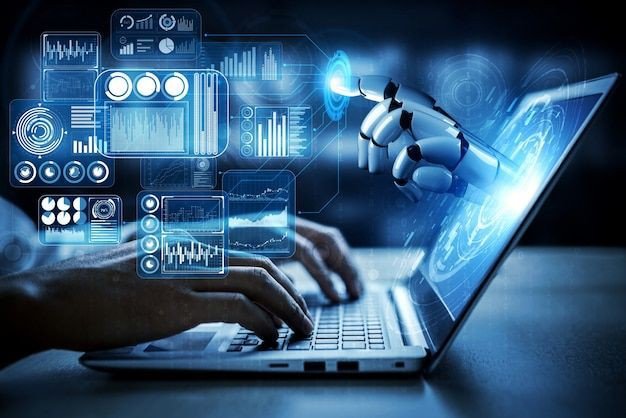
Introduction
Artificial Intelligence (AI) has rapidly transformed various aspects of modern life, from healthcare and finance to law enforcement and social media. AI algorithms are increasingly used to make decisions that significantly impact people’s lives, such as hiring, loan approvals, medical diagnoses, and criminal justice outcomes. While AI holds tremendous promise, it also presents significant challenges, particularly when it comes to bias. AI bias occurs when algorithms, either intentionally or unintentionally, produce unfair outcomes for certain groups based on race, gender, or other characteristics. This article delves into how AI can perpetuate racial and gender inequality, exploring the root causes of bias, real-world examples, and strategies for creating more equitable AI systems.
Understanding AI Bias: What Is It and Why Does It Matter?
AI bias refers to systematic and unfair discrimination embedded in algorithms, leading to prejudiced outcomes against certain groups. Bias in AI can occur at various stages, from data collection and processing to algorithm design and implementation.
Types of AI Bias
- Data Bias: The data used to train AI models can be biased if it reflects historical or social prejudices. For instance, if a dataset used to train a hiring algorithm predominantly consists of resumes from white males, the AI may learn to favor similar resumes, perpetuating existing racial and gender inequalities.
- Algorithmic Bias: The design and development of algorithms themselves can introduce bias. For example, if an algorithm is built with assumptions that do not account for the diversity of users or stakeholders, it may produce skewed results.
- Interaction Bias: Bias can emerge when AI systems learn from user interactions. For example, if a chatbot learns from biased or inappropriate conversations with users, it may start to generate biased or offensive responses.
Why AI Bias Matters
AI bias is a critical issue because AI is increasingly being used to make decisions that affect people’s lives. When these decisions are biased, they can reinforce existing inequalities and create new forms of discrimination:
- Impact on Opportunities: AI bias can limit access to jobs, education, loans, and other opportunities for marginalized groups.
- Legal and Ethical Concerns: Discriminatory outcomes resulting from biased AI can lead to legal repercussions and ethical challenges for organizations.
- Erosion of Trust: When people perceive AI systems as biased, it can erode trust in technology and discourage their use, especially among those who feel most disadvantaged.
How AI Algorithms Perpetuate Racial and Gender Inequality
AI systems often unintentionally perpetuate racial and gender inequality due to biased data, flawed assumptions, and a lack of diversity in AI development teams. Here are some ways in which AI perpetuates these inequalities:
1. Biased Data and Historical Prejudices
AI algorithms are only as good as the data they are trained on. When training data reflects historical biases and systemic discrimination, AI models can learn and replicate these patterns.
- Racial Bias in Facial Recognition: Facial recognition technology has been widely criticized for its racial bias. Studies have shown that these systems often have higher error rates when identifying people of color, particularly Black and Asian individuals. This bias can result from training the algorithms on datasets that are predominantly composed of lighter-skinned faces, leading to lower accuracy for darker-skinned individuals.
- Gender Bias in Language Models: Many AI language models are trained on vast amounts of text data scraped from the internet, which often contains biased language and stereotypes. For example, some models have been shown to associate specific job roles or characteristics with a particular gender (e.g., associating “nurse” with women and “engineer” with men). Such biases can reinforce harmful stereotypes and perpetuate gender inequality.
2. Flawed Algorithmic Design and Assumptions
AI algorithms are designed and developed by humans who may unintentionally encode their own biases into the system.
- Predictive Policing Algorithms: Predictive policing algorithms, which use data to forecast where crimes are likely to occur, have come under scrutiny for perpetuating racial biases. These algorithms often rely on historical crime data, which may reflect over-policing in minority communities. As a result, the AI may suggest increased police presence in these areas, reinforcing the cycle of over-policing and systemic discrimination.
- Gender Bias in Hiring Algorithms: Some companies have used AI algorithms to screen job applicants, but these systems can inadvertently learn biased patterns. For instance, a hiring algorithm trained on a company’s past hiring data may learn to favor male candidates if the company has historically hired more men. This bias can limit opportunities for women, especially in male-dominated fields like tech and engineering.
3. Lack of Diversity in AI Development
The lack of diversity among AI developers and data scientists can contribute to biased AI systems.
- Homogeneous Development Teams: When development teams lack diversity, they may overlook potential biases or fail to consider the impact of their designs on different groups. For example, an all-male team may not recognize that their facial recognition system performs poorly for women, or a predominantly white team may not notice racial biases in their algorithm’s outputs.
- Insufficient Stakeholder Involvement: A lack of engagement with diverse stakeholders during the design and deployment of AI systems can also contribute to biased outcomes. Ensuring diverse voices are included in the AI development process is crucial for identifying and mitigating biases.
Real-World Examples of AI Bias
Several real-world examples illustrate how AI bias can perpetuate racial and gender inequalities:
1. COMPAS and Bias in Criminal Justice
COMPAS (Correctional Offender Management Profiling for Alternative Sanctions) is a risk assessment algorithm used by some U.S. courts to predict the likelihood of a defendant reoffending. A 2016 investigation by ProPublica found that COMPAS was biased against Black defendants, falsely labeling them as high-risk at nearly twice the rate of white defendants.
- Root Cause of Bias: The bias in COMPAS likely stems from the use of historical crime data, which may reflect systemic racial biases in the criminal justice system, such as racial profiling, sentencing disparities, and over-policing in minority communities.
2. Amazon’s AI Recruiting Tool
In 2018, Amazon scrapped an AI recruiting tool that exhibited bias against women. The tool, which was designed to help the company automate the hiring process, was found to favor male candidates over female candidates. The AI model was trained on resumes submitted to Amazon over a 10-year period, many of which came from male applicants.
- Root Cause of Bias: The bias emerged because the training data reflected the existing male-dominated workforce in the tech industry. As a result, the algorithm learned to favor resumes that used language more commonly associated with men and penalized those that included terms more often found in women’s resumes.
3. Facial Recognition Technology and Racial Bias
Facial recognition systems developed by companies like IBM, Microsoft, and Amazon have been shown to have higher error rates for people of color, especially women of color. Studies by the Gender Shades project and the National Institute of Standards and Technology (NIST) found that these systems are more likely to misidentify or fail to recognize individuals with darker skin tones.
- Root Cause of Bias: The bias in facial recognition technology is often due to imbalanced training datasets that over-represent lighter-skinned faces and under-represent darker-skinned faces. Additionally, algorithmic flaws can arise when developers fail to account for diverse facial features across different racial and ethnic groups.
Addressing AI Bias: Strategies for Creating More Equitable AI Systems
To mitigate AI bias and create more equitable systems, it is essential to adopt a multi-faceted approach that involves technical, organizational, and regulatory measures.
1. Improving Data Quality and Diversity
Data is the foundation of AI, and improving the quality and diversity of training data is crucial to reducing bias.
- Inclusive Datasets: Developers should ensure that training datasets are representative of the diversity of the population. This involves collecting data from a wide range of demographic groups and ensuring that marginalized communities are adequately represented.
- Bias Detection and Correction: It is essential to regularly audit datasets for bias and use techniques to identify and correct biases in data. This could involve removing biased data points, rebalancing datasets, or using synthetic data to fill gaps.
2. Building Transparent and Explainable AI Systems
Transparency and explainability are critical to identifying and mitigating AI bias.
- Explainable AI: Developing AI models that provide clear and understandable explanations for their decisions can help identify bias. When users and stakeholders can understand how an AI model reaches its conclusions, it becomes easier to detect and correct biased behavior.
- Transparency in Algorithm Design: Companies should be transparent about their algorithms, including how they are designed, trained, and tested. This transparency can foster accountability and enable independent audits to identify and address bias.
3. Promoting Diversity in AI Development Teams
A diverse development team can help identify and mitigate biases that homogeneous teams may overlook.
- Inclusive Hiring Practices: Companies should actively promote diversity in their AI development teams by recruiting talent from underrepresented groups. Diverse teams are more likely to recognize and address biases that affect different communities.
- Stakeholder Engagement: Engaging with a broad range of stakeholders, including community groups, civil rights organizations, and ethicists, can provide valuable insights into potential biases and help design more equitable AI systems.
4. Implementing Regulatory and Ethical Guidelines
Regulatory frameworks and ethical guidelines can help ensure that AI systems are fair and unbiased.
- Government Regulations: Governments can introduce regulations that require companies to conduct bias audits, provide transparency reports, and adhere to standards for ethical AI development. The European Union’s proposed AI regulation, which includes provisions for high-risk AI systems, is an example of such an effort.
- Industry Standards and Guidelines: The tech industry can establish standards and best practices for ethical AI development. Organizations like the Partnership on AI and the IEEE Global Initiative on Ethics of Autonomous and Intelligent Systems are working to create ethical guidelines and promote fairness in AI.
Conclusion: The Path to Fairer AI
AI bias is a significant challenge that can perpetuate racial and gender inequality if left unchecked. While the potential benefits of AI are immense, the risks associated with biased algorithms are real and must be addressed proactively. Creating fairer AI systems requires a combination of technical, organizational, and regulatory measures that prioritize transparency, inclusivity, and accountability. By improving data quality, promoting diversity in AI development, and establishing robust ethical guidelines, we can work towards a future where AI serves everyone equitably, without perpetuating existing biases and inequalities.









